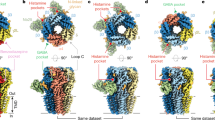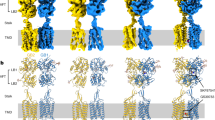Abstract
GABA (γ-aminobutyric acid) is the main inhibitory neurotransmitter in the mammalian central nervous system, where it exerts its effects through ionotropic (GABAA/C) receptors to produce fast synaptic inhibition and metabotropic (GABAB) receptors to produce slow, prolonged inhibitory signals. The gene encoding a GABAB receptor (GABABR1) has been cloned1; however, when expressed in mammalian cells this receptor is retained as an immature glycoprotein on intracellular membranes2 and exhibits low affinity for agonists compared with the endogenous receptor on brain membranes. Here we report the cloning of a complementary DNA encoding a new subtype of the GABAB receptor (GABABR2), which we identified by mining expressed-sequence-tag databases. Yeast two-hybrid screening showed that this new GABABR2-receptor subtype forms heterodimers with GABABR1 through an interaction at their intracellular carboxy-terminal tails. Upon expression with GABABR2 in HEK293T cells, GABABR1 is terminally glycosylated and expressed at the cell surface. Co-expression of the two receptors produces a fully functional GABAB receptor at the cell surface; this receptor binds GABA with a high affinity equivalent to that of the endogenous brain receptor. These results indicate that, in vivo, functional brain GABAB receptors may be heterodimers composed of GABABR1 and GABABR2.
This is a preview of subscription content, access via your institution
Access options
Subscribe to this journal
Receive 51 print issues and online access
$199.00 per year
only $3.90 per issue
Buy this article
- Purchase on SpringerLink
- Instant access to full article PDF
Prices may be subject to local taxes which are calculated during checkout




Similar content being viewed by others
References
Kaupmann, K.et al. Expression cloning of GABABreceptors uncovers similarity to metabotropic glutamate receptors. Nature 386, 239–246 (1997).
Couve, A.et al. Intracellular retention of recombinant GABABreceptors. J. Biol. Chem. 273, 26361–26367 (1998).
McLatchie, L. M.et al. RAMPs regulate the transport and ligand specificity of the calcitonin-receptor-like receptor. Nature 393, 333–339 (1998).
Kornau, H. C., Schenker, L. T., Kennedy, M. B. & Seeburg, P. H. Domain interaction between NMDA receptor subunits and the postsynaptic density protein PSD-95. Science 269, 1737–1740 (1995).
Brakeman, P. R.et al. Homer: a protein that selectively binds metabotropic glutamate receptors. Nature 386, 221–223 (1997).
Lupas, A. Coiled coils: new structures and new functions. Trends Biochem. Sci. 21, 375–382 (1996).
Barsomian, G. D.et al. Cloning and expression of peptide-N4-(N-acetyl-beta-D-glucosaminyl) asparagine amidase F in Escherichia coli. J. Biol. Chem. 265, 6967–6972 (1990).
Unson, C. G.et al. Characterization of deletion and truncation mutants of the rat glucagon receptor. Seven transmembrane segments are necessary for receptor transport to the plasma membrane and glucagon binding. J. Biol. Chem. 270, 27720–27727 (1995).
Kovoor, A., Nappey, V., Kieffer, B. L. & Chavkin, C. Mu and delta opioid receptors are differentially desensitized by the coexpression of β-adrenergic receptor kinase 2 and β-arrestin 2 in Xenopus oocytes. J. Biol. Chem. 272, 27065–27611 (1997).
Hebert, T. E. & Bouvier, M. Structural and functional aspects of G-protein-coupled receptor oligomerisation. Biochem. Cell. Biol. 76, 1–11 (1998).
Cvejic, S. & Devi, L. A. Dimerization of the delta opioid receptor: implication for a role in receptor internalization. J. Biol. Chem. 272, 26959–26964 (1997).
Hebert, T. E.et al. Apeptide derived from a beta2-adrenergic receptor transmembrane domain inhibits both receptor dimerization and activation. J. Biol. Chem. 271, 16384–16392 (1996).
Romano, C., Yang, W.-L. & O'Malley, K. L. Metabotropic glutamate receptor 5 is a disulfide-linked dimer. J. Biol. Chem. 271, 28612–28616 (1996).
Simmons, D. & Seed, B. Isolation of a cDNA encoding CD33, a differentiation antigen of myeloid progenitor cells. J. Immunol. 141, 2797–2800 (1988).
Harper, J. W., Adami, G. R., Wei, N., Keyomarsi, K. & Elledge, S. J. The p21 Cdk-interacting protein Cip1 is a potent inhibitor of G1 cyclin-dependent kinases. Cell 75, 805–816 (1993).
Bittiger, H., Reymann, N., Froestl, W. & Mickel, S. J. 3H-CGP 54 626: a potent antagonist radioligand for GABABreceptors. Pharmacol. Comm. 2, 23 (1992).
Weiland, T. & Jakobs, K. H. Measurement of receptor-stimulated guanosine 5′-O-(γ-thio) triphosphate in membrane preparations. Methods Enzymol. 237, 3–13 (1994).
Goldin, A. L. Maintenance of Xenopus laevis and oocyte injection. Methods Enzymol. 207, 266–279 ((1992).
Acknowledgements
We thank R. Solari and M. Roberts for comments on the manuscript, and the members of Receptor Systems for their support.
Author information
Authors and Affiliations
Corresponding author
Rights and permissions
About this article
Cite this article
White, J., Wise, A., Main, M. et al. Heterodimerization is required for the formation of a functional GABAB receptor. Nature 396, 679–682 (1998). https://doi.org/10.1038/25354
Received:
Accepted:
Issue Date:
DOI: https://doi.org/10.1038/25354



